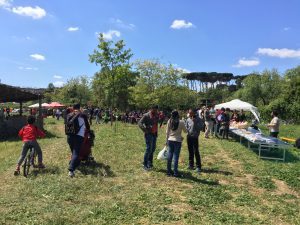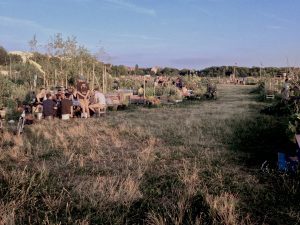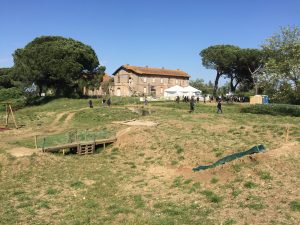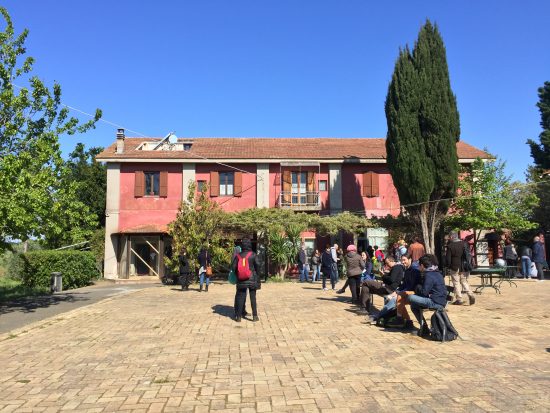European cities are still in the wake of the economic crisis. Public administrations are struggling with urban maintenance and the delivery of local services. Driven by community energies, citizen participation and a multi-stakeholder approach, small-scale local development is on the rise. Levente Polyak and Daniela Patti explain what is happening across Europe and how sustainable management, social cohesion and diversity of activities in urban areas is a growing trend.
“…civic participation brings along alternative catalysts, energies and resources into the design and management of urban public spaces.”
There has been a noticeable increase in small-scale local development and that European cities are focusing on this. What we would like to have a look at is: do you think that this is now a paradigm shift in urban planning?
Daniela: Yes, we can definitely see an increase in citizen initiated projects and this is clearly the result of the economic crisis. Often the funding mechanisms have changed; the public administration is struggling to maintain certain services and so hopefully, in the future this will allow for urban planning to include a more locally rooted approach, rather than exclusively large-scale development projects, that usually might not really be talking to the local community. However, in order to really be speaking about a paradigm shift we also have to talk about the involvement of stakeholders that are not only the community. Frequently, there is a local community and city administration working together. But, if we really want to reach a paradigm shift, even once the economic crisis is over, then the involvement of the private sector is crucial and all sides of public administration need to recognise the potential of including the community in certain projects. There is an increasing number of community-led projects that are sharing as well as developing alternative funding mechanisms behind their projects. And this is where we can see that there might be a potential for a paradigm shift. We can see that the funding mechanisms, especially for these spaces that would have once been part of our welfare, are now no longer provided only by public subsidies, but from a combination of private and community means. They are very often co-operative models where you have different types of stakeholders that are involved; and somehow this is more related to a new way of real estate management that we see both in the case of developing buildings, and in the case of managing green spaces. This is something that we have been researching upon recently and we can see that there are an increasing number of experiments and this gives hope that these new ideas and models might evolve in the future.
What trends are affecting the emergence of the new political acceptance of the new civic participation in green urban spaces?
Levente: One of the trends is obviously what Daniela mentioned, the economic crisis, which makes public administrations short of money to run services and developments. It is more and more recognised that civic participation brings along alternative catalysts, energies and resources into the design and management of urban public spaces. Governments are looking increasingly for political legitimacy, because they are perhaps seen as inadequate to represent communities. Consequently, there is a growing pressure on administrations that do not initially choose to involve communities, but in the end they are forced into it. Also, in relation to the crisis and diminishing resources, administrations are trying to outsource services.

Now, this can happen in some cases in contractual circumstances or in very spontaneous circumstances. Like now in Rome: the city has a lot of spontaneous take-overs of green-space management, often without contracts or shared resources. It is simply a very big citizen movement that is taking care of green spaces and vacant buildings. Now, if we look at different approaches or different levels of how participation is integrated into planning, urban design and management, we can see that, again depending on the city, depending on the cases, depending on the political circumstances, there are very different positions on the ladder of participation: sometimes there is real participation, in other cases we can speak of consultation or even lower degrees of involvement. Again, there are contractual or very spontaneous processes of outsourcing; also something that I think is very much quoted in the Netherlands nowadays: the right to challenge. In Britain, this is very much debated, because it is a conflictual model. If a community is not happy with the service the municipality is providing, the community can challenge and bid for the service. Now, this is happening in many places in Europe in a spontaneous way and without any legal framework. And I think one of the big questions that will be in all of these outsourcing processes is: what will make these models sustainable? What we are seeing is that in many places where the outsourced space or service management is completely run on voluntary energies, we cannot see where it is going and we do not know if it is a sustainable model or not. And I think the other big question is how can communities channel more and more professional expertise into these design and management processes, because again, voluntary energy is great, but I think you certainly need professional expertise. I think this is on the one hand the responsibility of professionals, like chambers of architecture or landscape architecture. On the other hand, the municipalities can encourage professionals to take part in these processes.
This brings us a little bit to the next point of a more political government perspective: what functions of green spaces are current governance trends emphasising?
Daniela: Well, connected to this you once would have had a distinction in green spaces between let’s say more pleasure and leisure green spaces: an England park for a nice walk or space for sports activities, and then productive landscape, such as agriculture, energy production, waste management or water treatment. These activities would have happened hidden and outside of the city because that is the type of green that we do not necessarily engage with too much. Now, there is a growing trend of mixing these two; mixing leisure spaces with productive landscape. This creates variety of which economic sustainability is formed. To give an example: it is one thing to cut the grass down: you need to hire somebody; you would need to use a lot of water. Another thing is to have production, to have agriculture on that land, then the land will be maintained by the farmers and the water that you are using is not just to make it green, but also to produce something and therefore there is an economic sustainability in this model, which is being further and further investigated. I think this then allows for a discussion as to which scale are we looking at, because obviously we are talking about green spaces that are part of a network.

There is a lot of discussion about leftover spaces in cities. Nowadays, there is big hype about the topic of urban farming. This has a very valuable aspect from an educational and social perspective such as taking care of public spaces and food security issues and also because it allows involvement from different segments of the community from age, ethnic background and so on. Urban gardening is maybe not necessarily the solution for self-sustainability from a food perspective for our cities, but it is definitely something very important, especially if you put it in a network of landscape and of green spaces on a city scale, or a metropolitan scale. Green spaces have the limit often of being very isolated, maybe they are coming as a result of a struggle of a local community that have had to fight against construction or an abandoned plot that they had to clean up and convert into a green space. Usually, there was a struggle for taking care of that space since the very beginning so then it is very hard to be additionally part of a network of spaces around the city, especially if we are talking about large ones. The limit is that these spaces lose their strength if they are just isolated little plots in the urban tissue, so this is why it is very important to build a network. This is where the administration has a really important role, because this is where it has much more possibility of having a citywide perspective than the local communities and it also has the means of creating an infrastructure around which these communities can cooperate with one another.
The administration has the role here of not only creating a network of urban gardens, but also connecting these small-scale spaces with larger plots, for example, the peri-urban landscape around cities. Usually, these spaces are bordering with peripheral neighbourhoods, which might not be the richest neighbourhoods of the city and having an agricultural area around them can allow for different perspectives and to find different qualities of life at the city’s outskirts. And this is where for example there is a growing attention towards peripheral landscapes that can combine recreational activities with production activities. There you have the advantages, unlike in the centre of the cities, that you have vast space; you have large plots of land. In the centre, you might have pocket gardens for leisure whilst on the peripheries you can also work on larger scale, which allows for having agricultural production. If we also talk about how a city can be sustainable this allows for the production of goods, maybe for recycling of organic waste, so you can really create a flow of resources within the city. Green spaces are part of an environmental network that does not follow administrative borders, that does not follow political borders and this is why cities have a very strong potential of being able to create an organic system between these green spaces, while communities can take care of some parts of this system.
Moving on to our next point, looking at how communities benefit from green space: you have given some examples of what is going on among cities with regards to urban farming, green space in the sense of parks, but can you give us some highlights, in your opinion, of what have been Europe’s best practices here?
Daniela: Communities can benefit from green space in terms of having recreational space, having a good quality of life, the possibility of having healthy environments and spaces for more social cohesion, but at the same time allow for a sustainable production and management of resources on a local scale. So it could be food production, organic waste management and treatment or energy production, which is part of the green network. These are benefits that the local community can have if the green spaces are managed according to these principles. So, going back to what we were saying, you can have this mix of recreational leisure spaces with productive spaces and the benefits the local community can have are various. The actors that are involved to allow this to happen are very important: public administration, the local community, but also the private sector. Green spaces give opportunities to many stakeholders. Local farmers, for instance, are small entrepreneurs with a more pragmatic perspective of the sustainability of green space.

A city with interesting experiments is of course Berlin. Known as the Tempelhof project, local community in Kreuzberg fought to prevent the former airport area from construction and today it is an amazing park with a lot of space that allows for a series of activities such as flying kites and high-speed skateboarding, which would not typically be allowed in every day public space. Another example is the Gleisdreieck, which was built as a participatory project that took over a landsite that was part of a railway area. This is again a very unusual landscape with a train going through the park raising potential issues of safety, because typically parks are completely isolated from everyday life. In both cases the participation process has allowed for inclusion of less common activities to be recognised and to take place.
A harvesting project called the Selbsternte in Vienna shows an example of a series of more productive activities. This is quite interesting, because it is initiated by a series of environmentalist associations and enterprises working together with the administration to provide plots for the local communities. Therefore, it is a sort of urban gardening, but it is with a higher level of management. There are certain associations that are taking care of the plots and citizens can rent segments to grow their products. Also in Vienna there is an energy park just outside the city. The Energiepark is a big plant in the landscape accommodating solar energy and biomass production incorporated with the agricultural activity. This is only partially accessible to the public because we are talking more about industrial use. Here the green space benefits the local community with a sustainable management of their resources.

In Rome, there are a lot of initiatives of citizens that take over green space. This can be a local garden, but also a lot of cases on a larger scale where farming becomes a political act. For example, in the ‘70s there were a lot of squatting initiatives in agricultural areas to prevent building speculation. So farming here is a political and civic engagement to protect the landscape, as in the case of the Cobragor cooperative. Recently there have been competitions for young farmers’ co-operatives to take over public unused land (bando terre pubbliche). There is a growing intention towards green space to allow for sustainability but also to create jobs, especially considering the present level of youth unemployment.
I think the last case I would like to mention is that of the Transition Towns, which is a movement that started in Ireland and Britain, where communities work towards creating an energy self-sustaining community. It is very interesting, because we could look at it somehow as a 21st century implementation of Howard’s garden city. Totnes in the UK is a town where a local community has decided to take on a plan for which they will go towards energy descent. So they are aiming to use their public space to promote a more sustainable development, which in practice means that green spaces for example, rather than having flowers, would have vegetables growing. This would be part of a small town strategy that synergises the energy production done at every household, the systems of recycling water combined with the system of the watering of the plants. Suddenly, you can see that somehow there is a growing awareness of how green spaces can really become part of an infrastructure of the city that can be managed by the local communities to really develop a city towards environmentally and economically self-sufficient models.
This interview by Luca Bródy and Brigid Mc Aleer was first published by the European Urban Knowledge Network.


